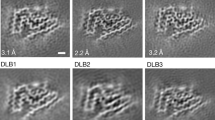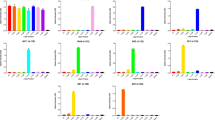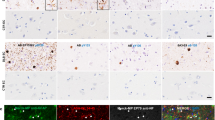Abstract
Mutations in the PARK7 gene DJ-1 are associated with recessive hereditary Parkinson’s disease (PD). Fibrillar inclusions of α-synuclein comprise the neuropathological hallmarks of PD and related Lewy body diseases as well as multiple system atrophy (MSA). Moreover, neuronal and glial inclusions containing tau have been observed in α-synucleinopathy patients. Using a collection of antibodies against DJ-1, we have performed a comprehensive investigation of DJ-1 in α-synucleinopathies and tauopathies. DJ-1 was abundantly expressed in reactive astrocytes of patients with neurodegenerative diseases. Likewise, DJ-1 antiserum immunostained reactive astrocytes that became abundant with disease progression in the brain stem of transgenic mice expressing mutant [A30P]α-synuclein. Human Lewy bodies as well as Lewy body-like inclusions in the α-synuclein transgenic mice were DJ-1 negative. Neuronal tau inclusions were DJ-1 immunopositive in Pick’s disease (PiD), corticobasal degeneration (CBD), progressive supranuclear palsy (PSP), and Alzheimer’s disease. In addition, we found DJ-1-immunopositive glial inclusions in CBD, PSP and MSA. Biochemical extraction experiments revealed the specific presence of insoluble, modified DJ-1 in PiD and MSA. Our results suggest that DJ-1 is up-regulated in reactive astrocytes as well as in neuronal and glial cells with specific α-synucleinopathy and tauopathy.



Similar content being viewed by others
References
Abou-Sleiman PM, Healy DG, Quinn N, Lees AJ, Wood NW (2003) The role of pathogenic DJ-1 mutations in Parkinson’s disease. Ann Neurol 54:283–286
Bonifati V, Rizzu P, Baren MJ van, Schaap O, Breedveld GJ, Krieger E, Dekker MCJ, Squitieri F, Ibanez P, Joosse M, Dongen JW van, Vanacore N, Swieten JC van, Brice A, Meco G, Duijn CM van, Oostra BA, Heutink P (2003) Mutations in the DJ-1 gene associated with autosomal recessive early-onset parkinsonism. Science 299:256–259
Braak H, Braak E (1991) Neuropathological stageing of Alzheimer-related changes. Acta Neuropathol 82:239–259
Braak H, Del Tredici K, Sandmann-Kiel D, Rüb U, Schultz C (2001) Nerve cells expressing heat-shock proteins in Parkinson’s disease. Acta Neuropathol 102:449–454
Buée L, Delacourte A (1999) Comparative biochemistry of tau in progressive supranuclear palsy, corticobasal degeneration, FTDP-17 and Pick’s disease. Brain Pathol 9:681–693
Cairns NJ, Atkinson PF, Hanger DP, Anderton BH, Daniel SE, Lantos PL (1997) Tau protein in the glial cytoplasmic inclusions of multiple system atrophy can be distinguished from abnormal tau in Alzheimer’s disease. Neurosci Lett 230:49–52
Cookson MR (2003) Crystallizing ideas about Parkinson’s disease. Proc Natl Acad Sci USA 100:9111–9113
Dekker M, Bonifati V, Van Swieten J, Leenders N, Galjaard RJ, Snijders P, Horstink M, Heutink P, Oostra B, Van Duijn C (2003) Clinical features and neuroimaging of PARK7-linked parkinsonism. Mov Disord 18:751–757
Dickson DW (2001) α-Synuclein and the Lewy body disorders. Curr Opin Neurol 14:423–432
Duda JE, Giasson BI, Gur TL, Montine TJ, Robertson D, Biaggioni I, Hurtig HI, Stern MB, Gollomp SM, Grossman M, Lee VM-Y, Trojanowski JQ (2000) Immunohistochemical and biochemical studies demonstrate a distinct profile of α-synuclein permutations in multiple system atrophy. J Neuropathol Exp Neurol 59:830–841
Giasson BI, Forman MS, Higuchi M, Golbe LI, Graves CL, Kotzbauer PT, Trojanowski JQ, Lee VM-Y (2003) Initiation and synergistic fibrillization of tau and α-synuclein. Science 300:636–640
Giasson BI, Lee VM-Y, Trojanowski JQ (2003) Interactions of amyloidogenic proteins. NeuroMolecular Med 4:49–58
Giasson BI, Mabon ME, Duda JE, Montine TJ, Robertson D, Hurtig HI, Lee VM-Y, Trojanowski JQ (2003) Tau and 14-3-3 in glial cytoplasmic inclusions of multiple system atrophy. Acta Neuropathol 106:243–250
Goedert M (2001) Alpha-synuclein and neurodegenerative diseases. Nat Rev Neurosci 2:492–501
Goedert M, Jakes R, Crowther RA, Cohen P, Vanmechelen E, Vandermeeren M, Cras P (1994) Epitope mapping of monoclonal antibodies to the paired helical filaments of Alzheimer’s disease: identification of phosphorylation sites in tau protein. Biochem J 301:871–877
Goedert M, Jakes R, Vanmechelen E (1995) Monoclonal antibody AT8 recognises tau protein phosphorylated at both serine 202 and threonine 205. Neurosci Lett 189:167–169
Görner K, Holtorf E, Odoy S, Nuscher B, Yamamoto A, Regula JT, Beyer K, Haass C, Kahle PJ (2004) Differential effects of Parkinson’s disease-associated mutations on stability and folding of DJ-1. J Biol Chem 279:6943–6951
Hague S, Rogaeva E, Hernandez D, Gulick C, Singleton A, Hanson M, Johnson J, Weiser R, Gallardo M, Ravina B, Gwinn-Hardy K, Crawley A, St. George-Hyslop PH, Lang AE, Heutink P, Bonifati V, Hardy J, Singleton A (2003) Early-onset Parkinson’s disease caused by a compound heterozygous DJ-1 mutation. Ann Neurol 54:271–274
Hod Y, Pentyala SN, Whyard TC, El-Maghrabi MR (1999) Identification and characterization of a novel protein that regulates RNA-protein interaction. J Cell Biochem 72:435–444
Jellinger KA (2003) Neuropathological spectrum of synucleinopathies. Mov Disord 18 (Suppl 6):S2–12
Kahle PJ, Neumann M, Ozmen L, Müller V, Jacobsen H, Schindzielorz A, Okochi M, Leimer U, Putten H van der, Probst A, Kremmer E, Kretzschmar HA, Haass C (2000) Subcellular localization of wild-type and Parkinson’s disease-associated mutant α-synuclein in human and transgenic mouse brain. J Neurosci 20:6365–6373
Kato S, Nakamura H (1990) Cytoplasmic argyrophilic inclusions in neurons of pontine nuclei in patients with olivopontocerebellar atrophy: immunohistochemical and ultrastructural studies. Acta Neuropathol 79:584–594
Lee S-J, Kim SJ, Kim I-K, Ko J, Jeong C-S, Kim G-H, Park C, Kang S-O, Suh P-G, Lee H-S, Cha S-S (2003) Crystal structures of human DJ-1 and Escherichia coli Hsp31, which share an evolutionarily conserved domain. J Biol Chem 278:44552–44559
Macedo MG, Anar B, Bronner IF, Cannella M, Squitieri F, Bonifati V, Hoogeveen A, Heutink P, Rizzu P (2003) The DJ-1L166P mutant protein associated with early onset Parkinson’s disease is unstable and forms higher-order protein complexes. Hum Mol Genet 12:2807–2816
McKeith IG, Galasko D, Kosaka K, Perry EK, Dickson DW, Hansen LA, Salmon DP, Lowe J, Mirra SS, Byrne EJ, Lennox G, Quinn NP, Edwardson JA, Ince PG, Bergeron C, Burns A, Miller BL, Lovestone S, Collerton D, Jansen EN, Ballard C, Vos RA de, Wilcock GK, Jellinger KA, Perry RH (1996) Consensus guidelines for the clinical and pathologic diagnosis of dementia with Lewy bodies (DLB): report of the consortium on DLB international workshop. Neurology 47:1113–1124
Miller DW, Ahmad R, Hague S, Baptista MJ, Canet-Aviles R, McLendon C, Carter DM, Zhu P-P, Stadler J, Chandran J, Klinefelter GR, Blackstone C, Cookson MR (2003) L166P mutant DJ-1, causative for recessive Parkinson’s disease, is degraded through the ubiquitin-proteasome system. J Biol Chem 278:36588–36595
Mirra SS, Heyman A, McKeel D, Sumi SM, Crain BJ, Brownlee LM, Vogel FS, Hughes JP, Belle G van, Berg L (1991) The Consortium to Establish a Registry for Alzheimer’s Disease (CERAD). Part II. Standardization of the neuropathologic assessment of Alzheimer’s disease. Neurology 41:479–486
Mitsumoto A, Nakagawa Y (2001) DJ-1 is an indicator for endogenous reactive oxygen species elicited by endotoxin. Free Radic Res 35:885–893
Mitsumoto A, Nakagawa Y, Takeuchi A, Okawa K, Iwamatsu A, Takanezawa Y (2001) Oxidized forms of peroxiredoxins and DJ-1 on two-dimensional gels increased in response to sublethal levels of paraquat. Free Radic Res 35:301–310
Moore DJ, Zhang L, Dawson TM, Dawson VL (2003) A missense mutation (L166P) in DJ-1, linked to familial Parkinson’s disease, confers reduced protein stability and impairs homo-oligomerization. J Neurochem 87:1558–1567
Nagakubo D, Taira T, Kitaura H, Ikeda M, Tamai K, Iguchi-Ariga SMM, Ariga H (1997) DJ-1, a novel oncogene which transforms mouse NIH3T3 cells in cooperation with ras. Biochem Biophys Res Commun 231:509–513
Nakazato Y, Yamazaki H, Hirato J, Ishida Y, Yamaguchi H (1990) Oligodendroglial microtubular tangles in olivopontocerebellar atrophy. J Neuropathol Exp Neurol 49:521–530
Neumann M, Adler S, Schlüter O, Kremmer E, Benecke R, Kretzschmar HA (2000) α-Synuclein accumulation in a case of neurodegeneration with brain iron accumulation type 1 (NBIA-1, formerly Hallervorden-Spatz syndrome) with widespread cortical and brainstem-type Lewy bodies. Acta Neuropathol 100:568–574
Neumann M, Kahle PJ, Giasson BI, Ozmen L, Borroni E, Spooren W, Müller V, Odoy S, Fujiwara H, Hasegawa M, Iwatsubo T, Trojanowski JQ, Kretzschmar HA, Haass C (2002) Misfolded proteinase K-resistant hyperphosphorylated α-synuclein in aged transgenic mice with locomotor deterioration and in human α-synucleinopathies. J Clin Invest 110:1429–1439
Niki T, Takahashi-Niki K, Taira T, Iguchi-Ariga SMM, Ariga H (2003) DJBP: A novel DJ-1-binding protein, negatively regulates the androgen receptor by recruiting histone deacetylase complex, and DJ-1 antagonizes this inhibition by abrogation of this complex. Mol Cancer Res 1:247–261
Olzmann JA, Brown K, Wilkinson KD, Rees HD, Huai Q, Ke H, Levey AI, Li L, Chin L-S (2003) Familial Parkinson’s disease-associated L166P mutation disrupts DJ-1 protein folding and function. J Biol Chem (in press)
Piao Y-S, Hayashi S, Hasegawa M, Wakabayashi K, Yamada M, Yoshimoto M, Ishikawa A, Iwatsubo T, Takahashi H (2001) Co-localization of α-synuclein and phosphorylated tau in neuronal and glial cytoplasmic inclusions in a patient with multiple system atrophy of long duration. Acta Neuropathol 101:285–293
Rizzu P, Hinkle DA, Zhukareva V, Bonifati V, Severijnen L-A, Martinez D, Ravid R, Kamphorst W, Eberwine JH, Lee VM-Y, Trojanowski JQ, Heutink P (2004) DJ-1 colocalizes with tau inclusions: a link between parkinsonism and dementia. Ann Neurol 55:113–118
Takahashi K, Taira T, Niki T, Seino C, Iguchi-Ariga SMM, Ariga H (2001) DJ-1 positively regulates the androgen receptor by impairing the binding of PIASxα to the receptor. J Biol Chem 276:37556–37563
Takeda A, Arai N, Komori T, Iseki E, Kato S, Oda M (1997) Tau immunoreactivity in glial cytoplasmic inclusions in multiple system atrophy. Neurosci Lett 234:63–66
Tao X, Tong L (2003) Crystal structure of human DJ-1, a protein associated with early onset Parkinson’s disease. J Biol Chem 278:31372–31379
Tolnay M, Probst A (1999) Tau protein pathology in Alzheimer’s disease and related disorders. Neuropathol Appl Neurobiol 25:171–187
Wagenfeld A, Gromoll J, Cooper TG (1998) Molecular cloning and expression of rat contraception associated protein 1 (CAP1), a protein putatively involved in fertilization. Biochem Biophys Res Commun 251:545–549
Acknowledgements
We thank P. Rizzu and P. Heutink for the donation of antisera against DJ-1, I. Pigur and S. Odoy for technical assistance, and M. Farrer for helpful discussions. This work was supported by the German National Genome Research Network (NGFN), the (N)EUROPARK consortium funded by the European Community, and the Deutsche Forschungsgemeinschaft (Collaborative Research Center SFB596 and KFO 113/1). The German Brain Bank “Brain-Net” (http://www.brain-net.net) is supported by the German Federal Ministry of Education and Research.
Author information
Authors and Affiliations
Corresponding author
Rights and permissions
About this article
Cite this article
Neumann, M., Müller, V., Görner, K. et al. Pathological properties of the Parkinson’s disease-associated protein DJ-1 in α-synucleinopathies and tauopathies: relevance for multiple system atrophy and Pick’s disease. Acta Neuropathol 107, 489–496 (2004). https://doi.org/10.1007/s00401-004-0834-2
Received:
Revised:
Accepted:
Published:
Issue Date:
DOI: https://doi.org/10.1007/s00401-004-0834-2




